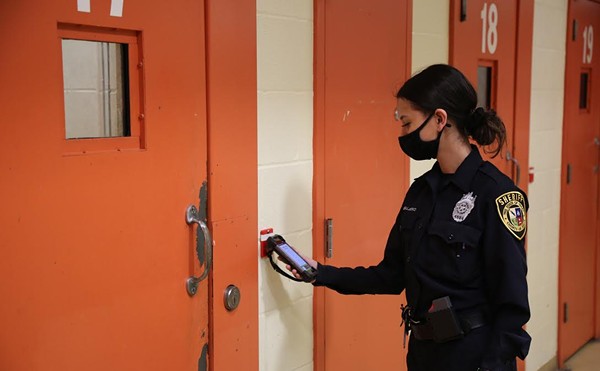Related: As Abortion Clinic Closures Loom in Texas, A Look Back at How We Got Here
Dr. Lester Minto didn’t give up after receiving numerous death threats. He’s persevered through virulent verbal attacks from anti-choice picketers that protest outside his Rio Grande Valley abortion clinic every weekend. The 64-year-old forgoes a salary and has for some time. None of this deters Minto from aiding the largely low-income, mostly Latina women that walk through his doors. But soon, Minto will call it quits.
In July, conservative Texas lawmakers convened during a second special session to pass legislation severely restricting abortion access. House Bill 2 bans abortion after 20 weeks of pregnancy and requires patients to follow outdated FDA protocol when taking abortion-inducing drugs. It also demands that abortion doctors secure hospital admitting privileges and compels abortion clinics to comply with the same standards as ambulatory surgical centers (ASCs)—stipulations that will force Minto to shutter his clinic after more than 30 years in practice and turn away the roughly 2,000 women he sees for preventative care and/or abortion services on an annual basis.
“I’ll have to close the clinic and sell off the building,” said Minto. “Financially, I can’t afford to keep it open.”
He’s far from alone. Reproductive health care experts estimate 37 of the state’s 42 abortion clinics will close as a result of the legislation, leaving just five centers located in four major cities to serve the entire state. For San Antonio, that could mean only one center would stay afloat. With just three other non-ASC abortion providers in the region, that lone clinic may very well serve all of South Texas.
Considering costs associated with travel, the sweeping restrictions disproportionately burden low-income women living in already underserved areas and increase the prospects of dangerous abortion methods, like obtaining unsupervised, black-market medication.
Opposed by major medical organizations such as the Texas Medical Association and the American Congress of Obstetricians and Gynecologists, the bill was propped up by the anti-choice community who offered negligible evidence or scientific fact of its ability to strengthen women’s health and safety, despite claiming that was their compassionate concern. While a potential lawsuit challenging the legislation looms, health care providers are scrambling to comply with regulations they say won’t help patient care. In the end, the cumulative effect of the legislation is expected to substantially erode safe, legal abortion care in Texas. To many skeptical followers of the issue, that’s exactly the point.
Crafted to ‘Shut Us Down’
Amy Hagstrom Miller, CEO of Whole Woman’s Health, oversees five abortion and reproductive care clinics, one of which is an ASC in San Antonio. Hagstrom Miller testified before the Texas Legislature during the abortion debate to seemingly deaf ears, assuring lawmakers the millions of dollars needed to comply with ASC standards in no way improve women’s care or safety. In fact, it would produce the opposite effect placing, “more women at risk for later term abortions or for illicit abortions outside the medical community” as health care providers disappear, unable to shoulder the extra costs.
The expensive upgrades—while wise for moderately complex surgery—are medically unnecessary in an abortion setting, says Hagstrom Miller. Abortion procedures usually last about 10 minutes, are performed under local anesthesia and no incision takes place, removing the need for costly retrofitting like larger operating rooms, janitor closets, locker rooms, wide hallways and additional airflow systems. For instance, a woman would not be wheeled in on a stretcher for such a procedure, making an 8-foot hallway far from essential.
Hagstrom Miller says clinics would have to shell out up to $1.4 million ($250-300 per square foot) for facility changes and upwards of $3 million to construct a new building. Whole Woman’s Health pays a hefty $40,000 a month in overhead costs to maintain its ASC—price points mostly out of reach for the smaller abortion clinics that dominate the state.
“The vast majority of people that provide abortion are small, independent providers who are community-based,” said Hagstrom Miller on the phone from her Austin headquarters. “They don’t have the money or the fundraising power to be an ASC.”
“The law is very well crafted to shut us down,” she said.
Independent, local providers like Minto’s Reproductive Services of Harlingen clinic have calculated the immense price. It would cost at least $750,000 to turn his center into an ASC. “There’s just not that much business, there’s not that much money. People are poor in the Valley,” he lamented. Even clinics with fundraising muscle and national recognition can’t guarantee they’ll stay open. Of the three Planned Parenthood abortion centers in San Antonio, none are ASCs. Mara Posada, communications director with Planned Parenthood of South Texas, says leadership is at the drawing board strategizing a plan to ensure services go uninterrupted. “We’re not sure what it’s going to look like, we’re still figuring it out,” she said.
While medical providers insist clinics will certainly shutter, conservative lawmakers, with no concrete proof, continually refuted the assertions and downplayed the law’s impact on abortion care. “There is nothing in this legislation that would close down an abortion facility,” said vocal anti-choice state Sen. Donna Campbell (R-New Braunfels) several times during Senate debate as well on national television. “If an abortion facility closes, it’s going to be because the millions of dollars that’s in the abortion industry is putting profit over a person.”
But lawmakers need only examine the not so distant past. A similar bill passed in 2004 required all abortions after 16 weeks to be performed at an ASC. Prior to the legislation, there were at least 20 different abortion providers that offered care after 16 weeks—once that bill was enacted there were none. It remained that way for some two and a half years. “Nobody in the state could build that quickly, or could retrofit their facility, so from 2004 until halfway through 2006, you couldn’t get an abortion at 16 weeks in the state of Texas,” said Hagstrom Miller, despite its complete legality under Roe v. Wade.
“To this day, only five of us have been able to find the resources to build an ASC,” she said. “And that took eight years.”
House bill author Rep. Jodie Laubenberg (R-Parker) answered a series of questions during the special session debate about her legislation with the ostensible claim that, “the bill is about the health and safety of women,” and Senate author Glenn Hegar (R-Katy) similarly reiterated the measures are meant to “increase the quality of the care” for women, yet neither legislator could provide evidence of how it would actually benefit safety. The argument was further tested when a Texas Department of State Health Services representative pointed out during a committee hearing that abortion clinics are inspected once a year, while ASCs are reviewed once every three to up to six years, meaning that the ASC requirement could reduce oversight of abortion clinics.
While reproductive rights advocates have drawn much attention to the ASC requirement, set to take effect in September 2014, clinics first face an equally complex challenge slated for implementation 90 days after the end of the second called session, which closed July 30. Under HB2, by this November all abortion physicians must obtain admitting privileges at a hospital within 30 miles of where the procedure is performed. Purportedly intended to make sure women have access to a hospital in case of an abortion-related emergency, health care leaders say the bill’s intent seeks to solve a problem that doesn’t exist and only creates another obstacle for abortion doctors.
One such opponent is the Texas Hospital Association, which lobbied against the legislation. During an early July House committee hearing, THA attorney Stacy Wilson testified that it would be unlikely that a non-abortion serving hospital (in other words, the majority of hospitals) would grant admitting privileges to an abortion doctor. Credentialing doctors who perform outpatient services is expensive and time-consuming for hospitals. Moreover, the system in place has worked effectively; today hospitals won’t turn away a woman suffering complications irrespective of admitting privileges.
Those difficulties aren’t common to begin with. According to the Guttmacher Institute, less than 0.5 percent of women obtaining legal abortions experience a complication and the risk of death associated with the procedure is roughly one-tenth of that with childbirth. In Texas, five abortion-related deaths have been reported since 2000, according to the Department of State Health Services. The last documented death occurred in 2008.
Minto’s experience reflects those statistics—he’s admitted one patient every 10 years over the past three decades.
Adding to the obstacle, hospitals may also fear aligning themselves with abortion providers after a conservative-led rule enacted earlier this year excluded abortion providers from a Medicaid-based health program. “It puts hospitals in a pickle—they know if they don’t give abortion doctors privileges, abortion centers will shut down,” said Hagstrom Miller. “But at the same time, if they do give privileges, are they going to be barred from accepting Medicaid?”
She continued, “It’s a perfectly designed Catch-22 in numerous ways.”
That goes double for religiously affiliated institutions. Securing admitting privileges at a religious hospital in rural Texas within 90 days notice is “next to impossible,” claims Hagstrom Miller. Minto knows that scenario all too well. The closest provider, Harlingen Valley Baptist Medical Center, would likely not admit him and even if they did, it wouldn’t be worth the time and effort for such infrequent admissions, he says.
“Many hospitals don’t take kindly to abortion doctors, we are kind of seen as the outcasts among physicians,” said Minto.
Separately, the provisions of the law are anticipated to corrode abortion access in Texas, but when working in tandem, the results are exponentially destructive.
“It’s no exaggeration that we’re going to go down from 42 sites to five—maybe,” said Hagstrom Miller. “It’s actually going to be less than five, with a combination of admitting privileges, the 20-week ban and ASC requirements … What’s really being crafted here is a perfect storm for those of us who have provided safe abortion care over the last 40 years.”
Desperate Times, Desperate Measures
In a state that claims the highest rate of uninsured citizens in the nation—for the fifth straight year, according to a Gallup report—resources like the Lilith Fund are oftentimes the only option for abortion-seeking women. The non-profit provides direct financial assistance to women unable to pay for abortion, serving more than 1,000 clients in 2012.
Though that figure set a record for the organization last year, it represents only one-third of the women who solicited the fund for aid, says Lindsay Rodriguez, San Antonio-based Lilith Fund board of directors member and president-elect. The Fund was unable to assist the other two-thirds. With the widely expected closure of all clinics west of I-35, Rodriguez grapples with the prospect of a massive surge in clients, as costs to obtain an abortion legally rise as women factor in other expenses, like transportation, lodging and securing child care. “The laws are going to be so devastating, it’s hard to foresee how the full impact is going to play out,” she said from her San Antonio satellite office.
Researchers with the Texas Policy Evaluation Project (TxPEP), a three-year study exploring the consequences of the State’s cuts to reproductive health funding, examined the potential on-the-ground effects of the ASC transition in smaller, underserved areas. With 80 percent of the state’s population living outside of the cities where ASCs are located—Houston, Dallas, San Antonio and Austin—the majority of Texas women seeking an abortion will likely need to take off work or school and travel long distances, spending increased time and money.
Rodriguez says today about 25 percent of the non-profit’s clients travel to SA clinics from surrounding towns, a figure likely to grow when the law is enacted. TxPEP found that the next closest ASC for women in El Paso, where the only two abortion providers do not meet ASC standards, is in San Antonio—a 560-mile trip and 32 hours of travel time cumulatively. Likewise, the nearest ASC for women living in the lower Rio Grande Valley is in San Antonio, meaning women in McAllen would need to travel roughly 235 miles and women in Harlingen would have to venture some 250 miles to obtain an abortion, tacking on about 16 hours of travel time to obtain the procedure over two visits, researchers noted.
Those travel times could double, as some women, unable to stay overnight in the city, may actually be forced to make up to four visits to San Antonio. Aside from the state-mandated ultrasound women must undergo 24 hours prior to the abortion procedure as per a controversial 2011 state law (which drops to two hours’ wait time if the woman lives more than 100 miles away from the nearest abortion provider), the bill forces women to physically return to the doctor’s office for their second dose of abortion medication—a rule major health groups argue is outdated and harmful to women. American Congress of Obstetricians and Gynocologists-Texas write the stipulation, “increases the risk of [the woman] not being able to return—this increases the chance for hemorrhage, blood transfusion and emergent D&C [uterine tissue scraping].” The Texas Medical Association came down on this part of the omnibus bill as well, writing it would set, “a dangerous precedent” for legislating the practice of medicine. A final follow-up visit is required not more than 14 days after the drug is administered or used, bringing the potential number of visits to four.
While public transit is available, albeit not highly connected, to Valley residents, connectivity in smaller communities and to colonias is, “sparse to non-existent,” a 2012 national transportation non-profit analysis reported.
Atop the weak transit network, transportation costs aren’t easy to come by for Valley women, who are among some of the poorest not only in the state but the country. According to U.S. Census Bureau figures, the area is one of the most impoverished nationwide, with a median family income of about $32,000 and 35 percent of households living below the federal poverty line.
“Overwhelmingly, this bill hurts low-income women,” declared Rodriguez, who says her organization is in the process of examining a new business model to determine if the Fund can also subsidize those transportation costs. “Women of means even before Roe v. Wade always had the option to go where it’s easier or where it’s legal, but the people that this really hurts will be the ones who don’t have things like extra money, paid time off or health benefits. And that’s cruel and unfair.”
While anti-choice lawmakers and activists often construct a false profile of an irresponsible party girl as the face of abortion-seeking women, the majority of women obtaining abortion are in their 20s and are mothers. According to Guttmacher, six in 10 U.S. women receiving an abortion already have a child and more than three in 10 have two or more children. Three-fourths of these women say the reason they abort is because they cannot afford a child.
The clients Rodriguez hears from fit this profile. “Most people that call us in San Antonio and farther south are already parents and cite financial instability as the reason for needing to get an abortion,” she says. “The women we talk to are ones that ask themselves if they could possibly put off buying groceries for the next few weeks so they can afford an abortion.”
With an influx of displaced clients from centers forced to shut down, the remaining clinics—such as the lone ASC in San Antonio—are set to experience an overflow of patients. In a domino effect, women pushed to the surviving centers will likely see longer wait times to get an appointment and delayed procedure dates, causing them to possibly undergo abortion later in the pregnancy, which is associated with a higher risk of complications, TxPEP researchers say.
That’s assuming women make the trip.
The TxPEP researchers predict some women may instead choose to physically self-induce their abortion or use black-market methods such as purchasing the abortion drug Misoprostol in Mexico or from flea markets, a trend already appearing in Texas according to a 2010 Reproductive Health Matters study.
Health care providers confirm the suspicions. Minto routinely sees Valley women opt for cheaper pills found in flea markets and Hagstrom Miller says she’s already noticing an increase in women trying to self-abort since the 2011 sonogram law at her McAllen location on the Texas-Mexico border as well as at her center in Beaumont, where the next closest abortion clinic is 350 miles away.
“In both communities I’ve seen women buying abortion medication on the black market and trying to self-induce,” said Hagstrom Miller. “Making two visits, and paying for child care and travel is too much for them with the laws already in place. As these new restrictions come down the pike—I don’t want to get too dramatic— but I’m already seeing a pre-Roe situation.”
Paula Saldana, a health instructor with the National Latina Institute for Reproductive Justice, educates Valley women about their options. The deep, pervasive Catholicism in the region and the traditional cultural mores leave many women fearful of exposing their identities when discussing abortion, she said.
“It’s always a friend or a cousin,” observed Saldana. “It’s never them. No one wants to talk about it, because it’s taboo.”
Most of the stories she hears are of women crossing over to Mexico for abortion medication—only a few can afford the prices at Valley clinics, which are below costs at other centers around the state. For as low as $15 a pill, unsupervised pharmaceuticals sold at flea markets are economically accessible for women, some of whom “don’t have running water in their communities,” says Saldana. Contributing to the inaccessibility of safe, legal abortion, the population’s undocumented immigrants can’t make the trek north past Border Patrol or move south to Mexico out of worry that they may be caught and unable to return to Texas.
“The number of unwanted pregnancies is going to go up for sure and the women that decide to go through with an abortion will be putting their life in danger,” she claimed.
Posada with Planned Parenthood recounted the story of a Brownsville woman who came to Planned Parenthood wanting a pregnancy test to see if she was “still pregnant.”
“The ‘still’ part raised our eyebrows. We learned she had taken some pills from a pharmacy in Mexico not under medical supervision and had to be rushed to a hospital for excessive bleeding. This doesn’t happen everyday, but it does occur,” Posada said.
“When a woman is desperate, she’ll do what she needs to do to terminate a pregnancy,” she continued.
A Shredded Network
While the legislation targets abortion, it could have the end result of further banishing basic women’s health care as clinics that also offer preventative services may close. With an already severely deteriorated women’s health care network, Texas may not withstand another hit.
The GOP-dominated state legislature slashed family planning funding by $74 million, or two-thirds, during the 2011 session. The results have already been deeply felt—according to the New England Journal of Medicine, more than 50 reproductive health clinics have closed their doors and an estimated 280,000 women are expected to lose basic services. With nearly 30 percent of Texans living without health insurance and efforts to expand federal Medicaid assistance blocked by conservative legislators, the overall reproductive health landscape appears fairly barren.
The most vulnerable and disadvantaged women must already choose between purchasing contraception and immediate economic needs, like gas and groceries, researchers with TxPEP found. Of the clinics that remain open, they’ve cut back on the most effective methods of contraception due to higher up-front costs, which, as researchers point out, may increase the likelihood of unintended pregnancy and thus, abortion.
Texas continues to experience a steady decline in available reproductive health care providers. Most recently, legislative cuts compounded with the removal of Planned Parenthood from the Medicaid Women’s Health Program forced three Planned Parenthood centers in East Texas to announce closure. Citing an “increasingly hostile environment for providers of reproductive health care in underserved communities,” clinics in Bryan, Huntsville and Lufkin will have to shutter this month. According to recent data provided by the Health and Human Services Commission, WHP program claims dropped from 23,407 in 2012 to 17,757 this year following the exclusion of Planned Parenthood.
San Antonio didn’t evade the massive legislative budget cutbacks—12 of 19 family planning centers in the city lost state funding, according to recent data from the Texas Policy Evaluation Project.
Additionally, more than 17,000 San Antonio-area women were served by the state’s family planning program in 2010; today, just 7,000 of these women are able to obtain reproductive health services. On a granular level, the state funds allowed more than 11,000 Bexar County residents to access affordable preventative health screenings and contraception—but following the statehouse slashes, only 4,700 women see these basic services.
In 2010 nearly 4,000 unintended pregnancies were averted in the San Antonio region as a result of state health family planning funding; after the removal of funds, the figure was reduced to less than half, according to TxPEP.
Dr. Janet Realini, president of Healthy Futures Texas and chair of the Texas Women’s Health Coalition, understands the city’s healthcare needs. She previously served as medical director of family planning at San Antonio’s Metropolitan Health District where she crafted the City’s teen pregnancy prevention program. Realini says although the city is relatively fortunate in terms of the number of institutions where low-income women can go to receive healthcare, access to basic family planning was a struggle even before the cuts. The blow to health funds immediately affected providers like the University Health System, which had to limit the number of patients from 10,000 to 2,300 after the cuts, said Realini in an interview.
“I think it’s concerning that it’s been harder to get appointments than it was before,” said Realini. “But we hope to see it improve with additional resources coming into the community.”
Her coalition is currently pressing the Department of State Health Services to ensure the $100 million allotted for family planning through primary care funding during the regular Legislative session does, indeed, restore women’s healthcare.
Lawsuit on the Horizon
Texas is among the several states nationwide that have passed severely restrictive abortion legislation. In the first six months of 2013 alone, legislators enacted 45 laws meant to restrict abortion access in the country—a figure higher than the total number in 2012, according to Guttmacher. Anti-choice groups like Americans United for Life, who handily draft model legislation for lawmakers, took full advantage of the legislative sweep, even overtly taking credit for bills in Texas. Denise Burke, vice president of legal affairs for AUL and a resident of San Antonio, explicitly stated the bill used language developed by her organization in a July newspaper editorial.
“This bill is model legislation identical to bills in other states,” said Heather Busby, executive director of NARAL Pro-Choice Texas. “It shows that women’s health and safety is a complete front. Lawmakers could not point to one concrete reason of how the changes would make things safer, but we do know the effect. The main intent of this bill is to make abortion inaccessible.”
Abortion rights proponents hope an expected legal injunction halts the bill’s implementation. With precedent on their side, Hagstrom Miller and the Center for Reproductive Rights are currently formulating a case to impede the restrictions. But while all four parts of Texas’ bill have been challenged in other courts around the country—from Arizona to Alabama—they did not appear in front of the notoriously conservative and largely anti-choice U.S. Fifth Circuit Court of Appeals. “It’s no secret that anti-abortion folks really want it to be challenged in the Fifth Circuit,” said Hagstrom Miller.
In the meantime, longtime providers like Minto brace for certain closure.
“I suspect that we’ll see so many girls, so desperate when pregnancy happens they’ll do anything—anything,” said Minto. “Throughout history when things are prohibited people still find a way to do it.”
Minto understands that providing the kind of care he’s offered for more than 30 years may soon be all but illegal. “There will be an underground network,” he predicted, “and I will be part of it.”


















